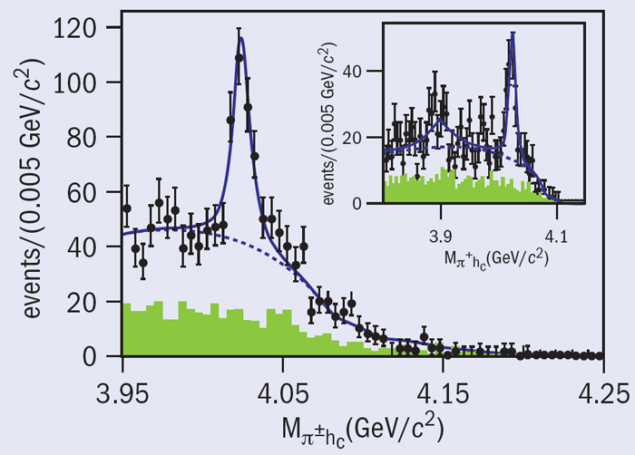
In studies at the Beijing Electron–Positron Collider (BEPCII), the international team that operates the Beijing Spectrometer (BESIII) experiment has found evidence for a family of what could well be four-quark states. The new results follow the discovery of the electrically charged Zc(3900) in March last year.
These breakthroughs are the result of a dedicated study by the BESIII collaboration of the decays of the puzzling Y(4260) state. Discovered by the BaBar collaboration at SLAC in 2005, this state has a well-established mass that is inconsistent with the interpretation that it consists only of a charm quark, c, and an anti-charm quark, c. Moreover, it tends to decay to charmonium (cc states) plus conventional mesons rather than to a pair of charmed particles, as expected for a particle of this mass. So, more complicated models for its composition need to be considered, such as the addition of more quarks to the system, the existence of excited gluons binding the cc system, or even more exotic scenarios. The problem has been to find a way to distinguish experimentally between the different theoretical possibilities.
By tuning the energy at which electrons and positrons annihilate at BEPCII to the mass of the Y(4260), the BESIII collaboration has been able to produce the state directly and collect large samples of its decays. The first surprising result was the discovery of the Zc(3900), a charged state that decays π± J/ψ. To decay this way, the Zc(3900) must contain a charm quark and an anticharm quark (to form the neutral J/ψ), together with something else that is charged, i.e., additional lighter quarks. Hence, it must be (at least) a four-quark object.
Since then, the BESIII collaboration has discovered a partner to the Zc(3900) – the Zc(4020). The new state appeared in the decay π±hc (BESIII collaboration 2013a). Like the Zc(3900), the Zc(4020) is electrically charged and decays to a particle consisting of a cc – in this case, the hc – so the interpretation is the same: it must also be a four-quark object. It appears, therefore, that the BESIII collaboration has begun to unveil a whole family of four-quark objects.
One possible clue for the interpretation of the Zc(3900) and Zc(4020) is that they appear near the minimum masses required to allow decays to pairs of D mesons (each consisting of a charm quark and an anti-up or anti-down quark). The Zc(3900) has a mass just above the combined mass of the D and D* and the Zc(4020) has a mass just more than twice that of the D*. So one idea is that the Zc(3900) is a four-quark bound state consisting of a D and a D*, each composed of two quarks. Similarly, the Zc(4020) could be a D*D* bound state. BESIII has explored this piece of evidence further by studying experimentally the charged D*D and D*D* systems, both of which show clear enhancements with properties similar to those of the Zc(3900) and Zc(4020) (BESIII collaboration 2013b and 2013c).
Another clue to the nature of all of these states came with the discovery of what appears to be a Y(4260) decaying to a photon and another particle, designated the X(3872) (BESIII collaboration 2013d). Unlike the Zc(3900) and the Zc(4020), the X(3872) is electrically neutral and has been experimentally established for more than 10 years. It has long been suspected of being a four-quark object, but it has been difficult to distinguish this interpretation from others as it has no electric charge. Now that BESIII has observed it alongside the Zc(3900) and Zc(4020), it seems that a definitive theoretical interpretation must be closer at hand.
Further reading
BESIII collaboration 2013a Phys. Rev. Lett. 111 242001.
2013b arXiv:1310.1163, accepted by Phys. Rev. Lett.
2013c arXiv:1308.2760, submitted to Phys. Rev. Lett.
2013d arXiv:1310.4101, submitted to Phys. Rev. Lett.





